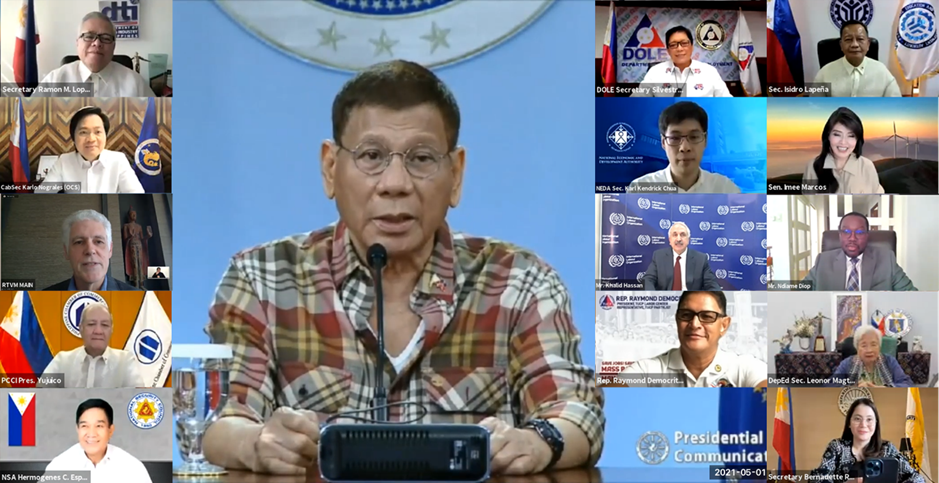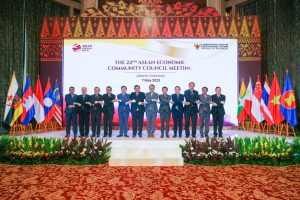
President Rodrigo Roa Duterte has signed Executive Order (EO) No. 140 officially adopting the National Employment Recovery Strategy (NERS) as the Philippine Government’s master plan for the restoration of the country’s labor market. The EO institutionalizes the 20-agency strong NERS Task Force (TF), charging it to implement the strategy from 2021 to 2022, in response to the effects of the COVID-19 pandemic.
The NERS 2021-2022 is an employment recovery plan anchored on the Updated Philippine Development Plan 2017-2022 and ReCharge.PH expanding the Trabaho, Negosyo, Kabuhayan initiative in consideration of the changes in the labor market brought by pandemic and the accelerated adoption of new technologies. It takes a whole-of-society approach in the development of a national strategy that addresses the social and economic issues arising from the lingering pandemic.
Under EO 140, the NERS is to precipitate the recovery of the labor market through (1) the creation of a policy environment that encourages generation of and improved access to employment, livelihood, and training opportunities; (2) the improvement of employability, wellness, and productivity of workers; and (3) the provision of support to existing and emerging businesses, ensuring the preservation of employment.
The EO details the composition and organization of the NERS TF, naming as Chair the Department of Trade and Industry (DTI), with the Department of Labor and Employment (DOLE) and the Technical Education and Skills Development Authority (TESDA) as Co-Chair. Members of the inter-agency TF include the Departments of Transportation (DOTr), Tourism (DOT), Public Works and Highways (DPWH), Science and Technology (DOST), Social Welfare and Development (DSWD), Agriculture (DA), Agrarian Reform (DAR), Interior and Local Government (DILG), Information and Communications Technology (DICT), Environment and Natural Resources (DENR), Education (DepEd), Finance (DOF), Budget and Management (DBM), the Commission on Higher Education (CHED), the National Security Council (NSC), the Office of the Cabinet Secretary (OCS), and the National Economic and Development Authority (NEDA).
The Task Force is given the following powers and functions:
- Formulate the NERS Action Plan, and make the necessary changes thereto, in order to address the recovery of the labor market, and the prevailing employment issues therein;
- Harmonize the employment, livelihood, and training projects and programs of the National Government towards the preservation and creation of more jobs;
- Foster strong partnerships that will complement and sustain efforts for stakeholders to recover, secure, and preserve employment, as well as rebuild the labor market;
- Tap the private sector employers’ groups, the International Labour Organization Country Office, and other partners, where mutually feasible, for joint programs and technical cooperation initiatives to augment and expand employment generation and livelihood projects;
- Identify existing relevant programs of the. member-agencies of the Task Force for harmonization with the NERS;
- Engage in promotional activities to expand the reach of the national and local employment campaign;
- Oversee the implementation of the NERS Action Plan, ensure the attainment of its objectives, and recommend measures to address gaps in implementation; and
- Perform such other functions as the President may direct.
The NERS TF was first organized on 5 February 2021, during the ceremonial signing of the NERS Joint Memorandum Circular constituting the group. On the 22nd of the same month, President Duterte approved the NERS during the 52nd Cabinet meeting and ordered the development of an EO institutionalizing the plan and the task force. The EO was originally expected to be signed last Labor Day during the TGER-NERS Job Summit on 1 May, but was still undergoing further review and improvements at the time.
EO 140 is expected to strengthen the NERS Task Force’s implementation of its Eight-Point Employment Recovery Agenda. First unveiled to the public during the TGER-NERS Job Summit, the P1.14-T plan is expected to generate at least 220,000 jobs and assist over 1.4 million Filipinos struggling with unemployment and income losses.
The conduct of the Job Summit, which brought together over 500 employers and worker groups represented by over 2,000 participants, forms part of the task force’s commitments under the agenda and demonstrates its resolve to engage the whole of society in its approach to recovery.
“We thank President Duterte for signing the landmark NERS 2021-2022, which is aimed at bringing back jobs and further strengthening the local workforce. This recovery plan also helps Filipino workers regain lost opportunities in the labor market since the onset of the pandemic,” said Trade Secretary Ramon M. Lopez, who also sits as Chair of the NERS Task Force.
Other items in the recovery agenda include the passage of legislation and policies that strengthen economic and employment recovery, the promotion of retooling and upskilling of workers, the implementation of youth employability programs, the provision of assistance to businesses in the form of loans, deferment of fees, upgrading of processes, etc., the provision of social protection to vulnerable groups, and the continuous monitoring and support to programs with high impact on employment.
Next in the pipeline is the approval of a proposed wage subsidy program for private-sector workers. The P24B safety net program can help retain as many as one million workers. Aimed at saving jobs and promoting employee retention, the program would provide workers with a monthly subsidy of P8,000 for up to three months. EO 140 orders the TF to “conduct a joint evaluation of the policies and effectiveness of the NERS” every three months. The Task Force is likewise directed to submit periodic reports on the results of the joint evaluations and the implementation of NERS to the Office of the President. ♦
Date of Release: 30 June 2021





